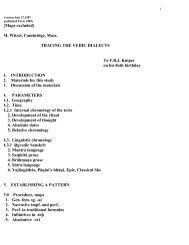The Languages of Harappa - People Fas Harvard
The Languages of Harappa - People Fas Harvard
The Languages of Harappa - People Fas Harvard
You also want an ePaper? Increase the reach of your titles
YUMPU automatically turns print PDFs into web optimized ePapers that Google loves.
esulted in the archaic compounds Ved. rathe-hå, Avest. raθaẽ-šta- 'chariot fighter', (cf.<br />
Old Avestan raθī, RV rathī 'chariot driver); cf. also the many IA names in the Near East<br />
containing this word, such as Tuš-ratta.<br />
This is something that cannot be said (yet) from the point <strong>of</strong> view <strong>of</strong> South Asian<br />
Archaeology. As is well known now, steppe influence is found in the BMAC but does not<br />
extend beyond it; instead, there is some BMAC influence that is found from Susa to<br />
<strong>Harappa</strong>. On the other hand, there is, for the period in question, a huge gap in exploration<br />
between Khorasan and Kabul for the mid- 2nd millennium BCE.<br />
None <strong>of</strong> the archaeologically identified post-<strong>Harappa</strong>n cultures so far found, from<br />
Cemetery H, Sarai Kala III, the early Gandhara and Gomal Grave Cultures, does make a<br />
good fit for the culture <strong>of</strong> the speakers <strong>of</strong> Vedic: one would have to look for remains that<br />
include horse and chariot, primitive ritual pottery (handmade) and remnants <strong>of</strong> fire and<br />
Soma rituals with wooden implements, burials both with interment and cremation, and the<br />
general kit <strong>of</strong> cattle herders moving about in transhumance fashion on heavy wagons and<br />
having some barley cultivation on the side.<br />
Another open question is the presence <strong>of</strong> speakers <strong>of</strong> Dravidian. <strong>The</strong> linguists have<br />
not yet decided whether they in fact originally were pastoral people from the mountainous<br />
areas <strong>of</strong> Greater Iran (Zvelebil 1970, 1990: 48, 123); others (Krishnamurti, forthc. @@)<br />
would have then inside South Asia at a very early date. In deciding this question, the<br />
agricultural loan word links <strong>of</strong> Dravidian with Sumerian will be <strong>of</strong> importance (Blažek and<br />
Boisson 1992); there also are some vague similarities with Caucasian languages in some<br />
loans words such as 'horse' and 'wheat' (Witzel 1999a, b). Such factors may indeed point to<br />
a western, Iranian location <strong>of</strong> Dravidian before immigration into South Asia (Southworth<br />
and McAlpin, 1979, however, think they participated in the Indus civilization, from which<br />
they acquired agriculture and the accompanying vocabulary). One thing is clear, though:<br />
Dravidian and Indo-Aryan (IE) words for domesticated animals are quite different from<br />
each other, for example, Drav. DEDR 500 Tam. ivui, Brah. (h)ullī, 1711 Tam. kutirai etc.,<br />
DEDR 3963 Tam. pari 'runner', 4780 Tam. må 'animal' (horse, elephant), Tel. måvu 'horsecf.<br />
Nahali måv 'horse' , (cognates mean 'deer' etc. in other Drav. languages); they have no<br />
relation with IA aśva 'horse' and various words for 'runner' (arvant, våjin, etc.). Ved.<br />
garda-bha EWA I 473, Drav. kau-tai DEDR 1364 'donkey') seem to be independent loans<br />
from a language <strong>of</strong> Greater Iran or Central Asia (Witzel 1999a, b).<br />
Early contact between both groups on the Iranian plateau, supposed by Southworth<br />
(1979: 203, 228 f., 1990: 222-3, 1995) is to be excluded (Witzel 1999 a,b); pace Southworth<br />
(1979: 196f.), there also is little secure evidence for early loans from IA into Drav.; such<br />
words can have been taken over any time between the RV (1200 BCE) and the earliest<br />
attestation <strong>of</strong> Tamil at the begin <strong>of</strong> our era.<br />
Against this background, it seems possible that (some) bands <strong>of</strong> speakers <strong>of</strong> early IA<br />
and Drav. entered South Asia independently <strong>of</strong> each other, perhaps even at about the same<br />
time: the IA via the Khyber and maybe some other passes in E. Afghanistan, and the Drav.<br />
via Baluchistan, both as pastoral peoples with very little agriculture; both exploited the<br />
system collapse <strong>of</strong> the Indus civilization, and occupied the newly open lands which could<br />
now pr<strong>of</strong>itably be used for pastoralism. In other words, the whole convoluted, and by now<br />
highly emotionalized, question <strong>of</strong> the so-called Aryan (and Dravidian) 'invasion' or

















